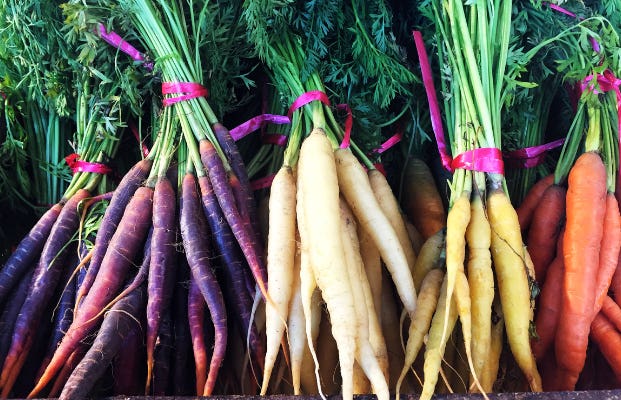
All About Carrots! Rainbow Hues, Using the Tops, and What are Baby Carrots, Really?
Rainbow hues, a range of sizes, and renewed interest in cooking the tops have made carrots cool again. Those bright carrots making a splash on spring produce displays aren’t new varieties. The surprising shades date back over a thousand years to when carrots were first cultivated. It wasn’t until the 17th century that hybridization led to the distinctive orange color that dominates the carrot market to this day. The color-saturated evolution also ensured we got carrots with more beta-carotene, the phytonutrient the body converts to vitamin A. Read on for more carrot tips!
What Different-Color Carrots Taste Like
Not all carrot varieties taste the same. Luckily, their color tells us a bit about their flavor.
- Classic orange carrots are sweet and juicy.
- Purple carrots have an earthy flavor, with some peppery notes.
- Red carrots are dense and less sweet than the other varieties.
- Gold/white carrots are super sweet, with a mellow flavor.
What to Do with Carrot Tops
Don’t discard your carrot tops, but do remove them as soon as possible. Carrot greens continue to draw moisture and nutrients from the carrots, which can make them go limp and dry out faster. Pluck the tender leaves from the carrot tops, then use them the way you would fresh parsley or basil in sauces, dressings, soups, and stews. You can also air-fry carrot tops for a crunchy garnish. Try our Carrot Top Pesto recipe!
How to Revive Limp Carrots
To restore the crunch of limp, bendy carrots, cut off the wide stem ends and soak them in cold water overnight.
What Are Baby Carrots, Really?
The term ”baby carrot” can cause a lot of confusion, because people use it to describe a few different types of carrots. Here’s what you need to know about baby carrots:
- True baby carrots are pulled from the ground before they’re fully mature. They are usually sold in bunches with greens attached and have their long taproots intact.
- Baby-cut carrots are full-size carrots that have been cut and whittled down to near-identical shape and size. You’ll find them in bags in the produce section of supermarkets.
- Nantes and Chantenay are carrot varieties that stay small even when mature. They’re sometimes marketed as French baby carrots.
Easy Braised Carrots
Carrots, with their bright color and sweet flavor, make an ideal side dish. In this easy braised carrots recipe, toasted cumin seeds (or coriander, caraway, or fennel seeds) and a splash of maple syrup heighten their natural sweetness while adding an earthy touch. Serve with a drizzle of citrus juice (optional). Ready in 25 minutes. Makes 3½ cups.
Ingredients
1 teaspoon whole cumin, coriander, caraway, or fennel seeds
4 cups sliced carrots or halved baby carrots
2 cups low-sodium vegetable broth or water
1 teaspoon pure maple syrup
2 tablespoons lemon, lime, or orange juice (optional)
Instructions
1. In a large skillet toast seeds over medium 1 minute or until fragrant, stirring frequently. Add carrots, broth, and maple syrup. Reduce heat to medium-low. Cover and simmer 10 minutes.
2. Uncover; increase heat to medium. Continue cooking until most of the liquid has evaporated and carrots are tender. Just before serving, drizzle carrots with citrus juice (if using).
More Recipes
For more inspiration, check out our top-rated carrot recipes!

About the Author

About the Author
Mary Margaret Chappell
Join our mailing list
Get free recipes and the latest info on living a happy, healthy plant-based lifestyle.
By providing your email address, you consent to receive newsletter emails from Forks Over Knives. We value your privacy and will keep your email address safe. You may unsubscribe from our emails at any time.